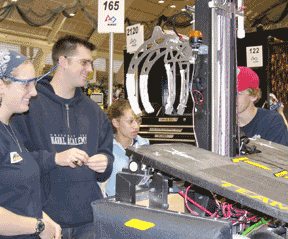 |
|||||||||||
|
|||||||||||
|
|||||||||||
Not All Is Lost in March MadnessThe robotic Power Hawks of South River High School live to play another roundstory by Ben Miller; photographs by Cathy C. Miller
As Maryland’s men’s and women’s basketball team stalled in the second rounds in their flings with March Madness, the Power Hawks of South River High School moved onto championship competition. In a wild weekend of another kind of March Madness at the U.S. Naval Academy’s Halsey Field House, 58 teams of high schoolers — including the Power Hawks — and their robots competed in the Chesapeake Regional of the FIRST Robotics competition. Like the NCAA basketball March Madness, kids dressed in crazy costumes; adults dressed in crazy costumes; and a dog, a lion, a pirate and a Campbell’s soup can high-fived the crowd as rock music blared. Tension built as teams moved into the final round. Unlike the basketball games, nobody here went down in defeat. The winners applauded the losers, the losers applauded the winners, and the judges, referees, announcers and supporters applauded everybody. Another difference: The Power Hawks’ game is played not by lithe, leaping giants but by robots. A robot’s collapsible arms can be as neatly articulated as a jump shooter’s letting fly a basketball. But, rather than dunk round balls in conical nets, the robots spindle plastic inner tubes on the outstretched spider arms of a goal in the center of a court roughly the size of a basketball half-court. Robotic matches are short and frenzied. Six determined robots compete for 135 seconds. For the first 15 seconds, the robots fumble for the goal alone. But to score they need a team. For the next two minutes, human players direct their robots. One team member hurls the inner tubes onto the floor. A driver commands the robot to break toward the goal. An operator guides the robot’s arms to scoop the inner tubes and score. An adult mentor coaches the play on the floor. For each game, three teams on a side form Red and Blue Alliances. Just as in basketball, a robot team could decide to score if it had a good scorer or to block out a quicker opponent. The alliances shift, with every game requiring teams to cooperate with two new teams while competing against the three other teams. Just as a basketball uses passing partnerships to score, alliance robots cooperate to earn points by rushing home and lifting an alliance member off the floor before the final buzzer. Zebra-shirted referees watch every move. Blue-shirted judges evaluate teams for professionalism, team-spirit and cooperation. This game emphasizes a word coined just for it: coopertition (competition plus cooperation). It is not all about scoring the most points. Moving on in the BracketsAt the end of this round, six teams earned the right to move on to the championship in the Georgia Dome in Atlanta, April 12 to 14. The winning alliance came from New Jersey’s Hillsborough, Hopewell Valley Central and Camden County Technical high schools. These teams will move on. Also advancing are three teams awarded high honors by the judges. Dulaney High School of Timonium captured the Regional Chairman’s award for creating the best partnership and for inspiring respect for science and technology. Woodlawn High School with the Brauckmann and Clash families in Baltimore took the Engineering Inspiration Award for their respect and appreciation of the engineering profession. The Episcopal Academy of Merian, Pennsylvania, earned the right by receiving the Rookie All-Star award. The Power Hawks of South River High School will go to Atlanta because of perseverance. They won their ticket after an early lead faded for their four years’ record in competition. That’s quite an honor. Overall, the FIRST Robotic Competition — the brainchild, along with the Segway and many other inventions, of innovator Dean Kamen — has 1,307 teams, 37 regional elimination rounds and a national championship in Atlanta. From seven countries, all 50 states and Puerto Rico, 32,625 high school students compete. The Power HawksThe Power Hawks of South River High School in Edgewater entered the robot Heavy Mettle — who, like all the other FIRST robots, was designed and built from common parts in six weeks. Colin Bailey, a three-year veteran, led the drive team that maneuvers the robot on the floor. During “build season,” Bailey explained, South River’s 37-student team plus their teachers and mentors spent every night and weekend with Heavy Mettle in the school woodshop. “If we can’t fix it, it’s not broken,” say the Power Hawks, who are happy to compete in Atlanta. “Yes, we’re going,” said Janina Vaitkus, a sophomore interested in biotechnical engineering and one of seven girls on the team. Vaitkus was also pleased with the Power Hawks’ performance in the regional. “With the complexity of the game and the short time we had, I feel we accomplished what we wanted,” she said. The judges awarded the Power Hawks the Johnson & Johnson Sportsmanship award for “outstanding sportsmanship and gracious professionalism in the heat of competition, both on and off the playing field.” Das GoatIf robots respond to a home-court advantage, the advantaged robot belongs to Das Goat, the team of 30 students from Severn, Broadneck and St. Mary’s high schools sponsored by the U.S. Naval Academy. The competition is the senior engineering project for six academy first classmen, who major in electrical and mechanical engineering. Midshipmen and students designed and built the robot with help from the Naval Academy shop. After years of classroom study, this is their “first practical project. It has to be done in a short amount of time and it is a trouble-shooting project,” said Currie Wooten, who teaches electrical engineering at the Academy and mentors the team. These are “bright kids,” said mentor First Classman Derek Anastasiades, a mechanical engineering major from Rhode Island. Das Goat has another advantage besides home court. It can rack up points by using its ramp to lift another robot. So that team made the final round by allying with another team. The team advanced in the final round, but not to the final game — nor to Atlanta. Winning isn’t EverythingUnlike the NCAA’s March Madness, winning isn’t everything in robotic competition. Technical ability and teamwork are the two main criteria on which volunteer judges evaluate the teams, according to judge Jeremy Rissi. As well as score points, these teams must develop an organization, a business plan and a schedule. They raise money, select nicknames and come up with crazy costumes. According to Woodie Flowers, co-founder of the FIRST Robotics Competition, they’ve “created a microcosm of the real engineering experience.” “Innovation,” said Rissi, “is not just a good idea. It is the execution of that idea.” It’s a lot like life. You can’t do it alone, and you need people with a variety of skills on your team. Writer Ben and photographer Cathy Miller are a team in life as well as for Bay Weekly. |
|||||||||||
|
|||||||||||
|
|
|||||||||||
|
© COPYRIGHT 2007 by New Bay Enterprises, Inc. All rights reserved. |
|||||||||||

